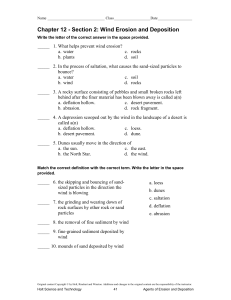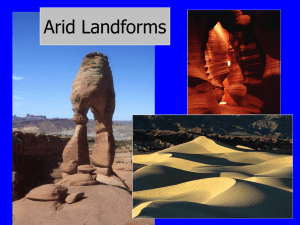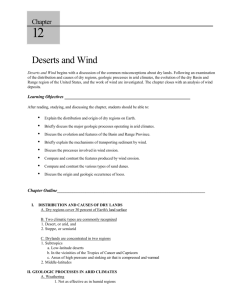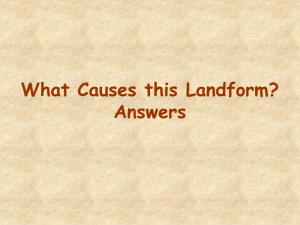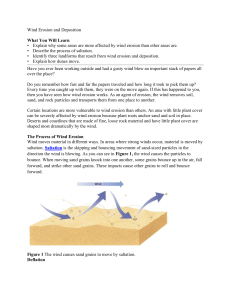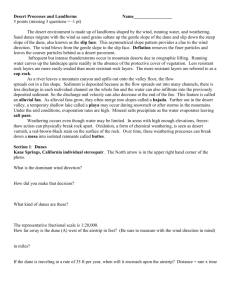18. Arid Landforms: Fluvial and Eolian Processes in Arid Zones
advertisement
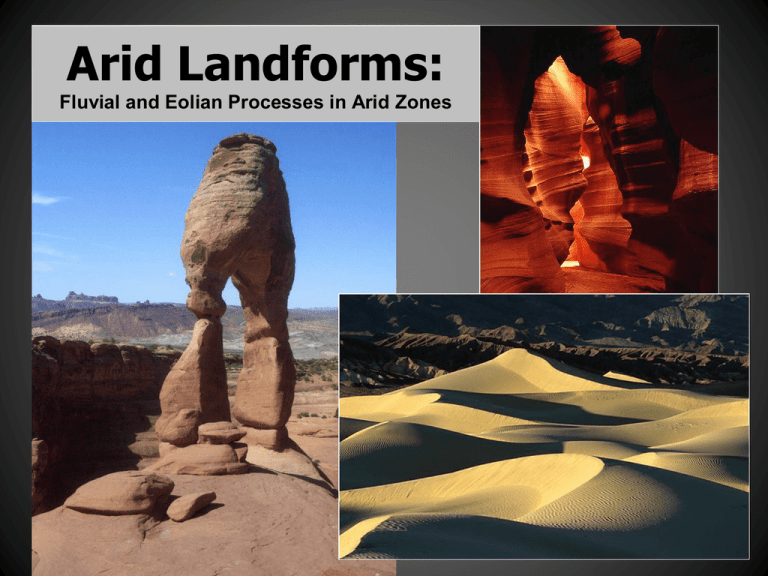
Arid Landforms: Fluvial and Eolian Processes in Arid Zones Global Distribution of Arid/Desert and Semi-arid/Steppe Regions Types of Deserts Erg – Sea of Sand • Largest are in Sahara and Arabian Deserts • Sand covers about 20% of world’s deserts • Vegetation is rare • Sand probably formed during more humid climate Namib Desert, Namibia Death Valley N.P., California Hamada – Bedrock predominates Death Valley N.P., California Desert varnish – oxidation of iron and manganese, useful for dating desert surfaces Arid Landscapes: Basic Concepts I. Most deserts exhibit highly angular landscapes. • mechanical weathering dominates • angular particles of weathered rock; bedrock outcrops with wind erosion • little soil or vegetation to soften landscape II. Softer, more rounded landscapes appear where deposition is predominant. • dunes • alluvial fans III. Desert rainfall is infrequent, intense, and unreliable. • intense flash flooding, intense erosion • ephemeral streams Joshua Tree N.P., California Las Vegas Flash Flood Wash Arroyo The Nile River meanders through the Sahara A braided stream near Chinle, Arizona FLUVIAL LANDFORMS IN ARID REGIONS Fluvial Erosion – sporadic nature of desert runoff (rare, intense flash floods), and lack of vegetation to protect surface materials causes rapid erosion. • Ephemeral stream channels – washes or arroyos (orwadis in the Middle East, and barrancas in Latin America) • Even streams originating in humid regions cannot maintain sufficient discharge and eventually disappear • Steep slopes – steep-walled canyons Mesas and Buttes Slot Canyon The Narrows, Zion N.P., Utah Differential Erosion MESA AND SCARP TOPOGRAPHY Pediments and Inselbergs – eroded bedrock and resistant knobs Inselberg - “island mountains” rise abruptly out of desert landscapes Uluru (Ayers Rock), Australia Bornhardt highly resistant rock landform; a type of inselberg. Kata Tjuta (The Olgas), Australia A Bornhardt in Arches National Park, Utah The Badlands of South Dakota – Impermeable clays and lack of soil cover produced rapid runoff, and a dense network of barren ridges dissected by a maze of steep, dry gullies and ravines – Badlands topography. Fluvial Transportation – large amounts of rock and sand moved short distances during sporadic flows Fluvial Deposition – alluvium deposits at the base of mountains or in closed basins – does as much to level the land as does erosion – differentiated from coarse to fine • Alluvial fans Bajada Piedmont Alluvial Plain • Rock debris in piedmont region Debris flow fans • Desert basins of interior drainage – Bolsons Playas Also playa lakes, clay pans, salinas, salt flats (or salt-crust playas) Piedmont – gently sloping land that extends out from the base of mountains, composed of a series of alluvial fans – (depositional). Pediment – sloping bedrock at base that develops due to gradual retreat of the adjoining mountain slope – (erosional). Badwater, Death Valley, CA Bajadas Death Valley N.P., California BASIN AND RANGE TOPOGRAPHY Playas EOLIAN (WIND) PROCESSES AND LANDFORMS Eolian Erosion - much less effective than fluvial • deflation – picking up and moving small particles of rocks; helps produce deflation hollows and desert pavements • abrasion – like sandblasting effect; polishes and etches exposed surfaces; produces ventifacts and yardangs Eolian Transportation - moves nothing bigger than coarse sand • duststorms - can extend thousands of feet up • sand storms - only very near the surface Eolian Deposition - dunes form and shift where winds and terrain slow the winds or block movement of dunes; loess deposits – wind-deposited silt ← dust storms Wind Transportation Mechanisms Dust Storm, Senegal Sand Storm EOLIAN (WIND) EROSION FEATURES “Desert pavement” of pebbles and stones – result of deflation • all small materials and sand removed by wind • very thin coating of stones Desert pavements: Also known as: “gibber” in Australia “reg” in North Africa Wind Erosion Features: An Yardang in the Kharga Depression, Egypt Ventifacts, Yardangs, Pedestal Rocks A sand-blasted rock, or Ventifact, on Mars Pedestal Rocks (Rock Mushrooms) in Utah’s Goblin Valley S.P. EOLIAN (WIND) DEPOSTION FEATURES Active/Shifting/Migrating Dunes Types of Dunes BARCHAN TRANSVERSE DUNES LONGITUDINAL DUNES (SEIFS) Types of Dunes Barchans - migrating crescent dune with horns pointing downwind; form where strong winds blow in a consistent direction. Move fast. Common in central Asia and Sahara. Can reach hundreds of feet in height. Transverse Dunes - parallel waves of crescent dunes perpendicular to wind direction; migrate downwind. Found in areas with large supply of sand. Seifs – multiple, very long, narrow, parallel dunes. They occur in areas with at least two dominant wind directions. Can be tens of miles long. More common outside the U.S. Other Types of Dunes Star Dunes Stabilized Dunes – when plants establish themselves in a dune area Loess Deposits: Wind-deposited silt, transported by dust storms; vary in thickness from few inches to over 300 feet Gully eroded thick loess in Northern China Unstable loess bluffs in Vicksburg, Mississippi Major Loess Regions of the World (Most loess deposits are peripheral to deserts and recently glaciated areas) Finally, Combined effects of Weathering, Mass Wasting + Fluvial and Eolian processes! Delicate Arch, Arches National Park, Utah

